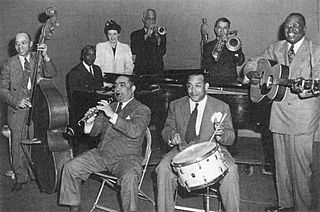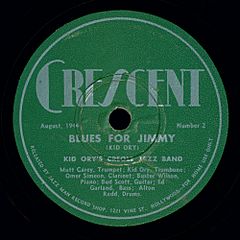Jimmie Noone facts for kids
Quick facts for kids
Jimmie Noone
|
|
|---|---|

Jimmie Noone c. 1920
|
|
| Background information | |
| Born | April 23, 1895 Cut Off, Louisiana, U.S. |
| Origin | New Orleans |
| Died | April 19, 1944 (aged 48) Los Angeles, California, U.S. |
| Genres | Jazz, Dixieland |
| Occupation(s) | Session musician, bandleader |
| Instruments | Clarinet |
| Years active | 1912–1944 |
| Labels | Vocalion, Decca |
| Associated acts | Freddie Keppard, Buddie Petit, Lorenzo Tio, Papa Celestin, Joe "King" Oliver, Doc Cook, Kid Ory |
Jimmie Noone (born April 23, 1895 – died April 19, 1944) was an American jazz clarinet player and band leader. He started his music journey in New Orleans. Later, he led a famous band in Chicago called Jimmie Noone's Apex Club Orchestra. They made many recordings for Vocalion and Decca record labels.
A famous classical composer, Maurice Ravel, even said he got the idea for his piece Boléro from Jimmie Noone's music. Towards the end of his life, Noone was leading a band in Los Angeles. He was also part of a group of amazing musicians who helped bring back interest in traditional New Orleans jazz in the 1940s.
Contents
Jimmie Noone: A Jazz Clarinet Legend
Early Life and Musical Start
Jimmie Noone was born on April 23, 1895, on a farm in Cut Off, Louisiana, United States. His parents were Lucinda and James Noone. He grew up in Hammond, Louisiana, where he first learned to play the guitar.
In 1910, Jimmie's family moved to the lively city of New Orleans. There, he switched from guitar to the clarinet. He was lucky enough to study with great clarinet teachers like Lorenzo Tio and a young musician named Sidney Bechet.
Building a Career in Jazz
By 1913, Jimmie Noone was playing music professionally in Storyville. He played with Freddie Keppard, taking the place of Sidney Bechet. In 1916, when Keppard went on tour, Noone and Buddie Petit started their own group, the Young Olympia Band. Noone also led a small band with just a clarinet, piano, and drums, which was quite unusual for that time.
In 1917, Noone played with Kid Ory and Oscar Celestin. This was until the Storyville district, a famous music area, was permanently closed. He then joined Keppard again in the Original Creole Orchestra. They performed on the vaudeville circuit, which was like a traveling variety show, until the group stopped playing together the next year.
In 1918, Jimmie Noone moved to Chicago, Illinois. There, he continued to improve his clarinet skills by studying with Franz Schoepp, a symphony clarinet player. For two years, from 1918 to 1920, he played at Chicago's Royal Garden Cafe. He performed with other jazz greats like Paul Barbarin and King Oliver. In 1920, Noone joined Doc Cook's dance orchestra. He played both saxophone and clarinet for six years in that band.
The Apex Club Orchestra
In 1926, Noone started leading his own band at the Apex Club in Chicago. This club was one of many popular Jazz Age clubs on Chicago's South Side. Jimmie Noone's Apex Club Orchestra had a unique setup. It featured a clarinet and an alto saxophone playing the main melody. The band also included a piano, drums, and guitar.
Noone signed with Brunswick Records in May 1928. His first recording session produced popular songs like "Four or Five Times." Jazz historian Richard Hadlock noted that Noone's band kept the spirit of New Orleans music alive. They did this without using brass instruments, which was different from many other bands. Noone's playing style mixed traditional New Orleans jazz with the newer, exciting swing solo playing.
Jimmie Noone's music inspired the famous composer Maurice Ravel to create his 1928 piece, Boléro. Even young musicians like Benny Goodman would often visit the Apex Club to listen to Noone. Goodman later used Noone's beautiful tone in his own playing. A very young Nat King Cole also listened to Noone's band on the radio. He would even sneak out to sit in the alley outside the club to hear Noone and Earl Hines. Years later, the first song Nat King Cole ever sang professionally was "Sweet Lorraine," which was Noone's theme song.
Noone continued to work in Chicago clubs throughout the 1930s. He recorded with Doc Cook's band and his own. He also went on long tours across the country, including performances back in New Orleans. He signed with Decca Records in 1936 and also recorded for Bluebird Records. As swing music became very popular, Noone tried leading a big band. However, he soon returned to his smaller band style.
Later Years and a New Orleans Jazz Revival
In 1943, Jimmie Noone moved to Los Angeles, California. At this time, there was a growing interest in traditional New Orleans-style jazz. Noone's popularity grew again when his old 1928 recordings were re-released.
When Noone arrived in Los Angeles, he faced challenges finding a home for his family due to wartime conditions. His wife, Rita, and their three children had to move back to Chicago for a while. This was a difficult time for Noone, and the stress affected his health. By February 1944, he finally found a home in Los Angeles, and his family was able to join him.

On March 15, 1944, Noone joined an amazing all-star band on CBS Radio's The Orson Welles Almanac. This band was very important in bringing back interest in New Orleans jazz. Orson Welles, a big fan of traditional jazz, asked Marili Morden to put together an authentic jazz band for his radio show. She quickly gathered talented musicians like Mutt Carey, Kid Ory, and Jimmie Noone. Their performances on the Welles show were so popular that the band became a regular feature. This helped launch Kid Ory's comeback in music.
Noone performed on four broadcasts of The Orson Welles Almanac. Sadly, on the morning of the fifth broadcast, April 19, 1944, Jimmie Noone suddenly died at home from a heart attack. He was 48 years old. Orson Welles called Kid Ory and asked him to write a blues song to play on that evening's radio show. Welles suggested they call it "Blues for Jimmie."
"Blues for Jimmie"
In 1952, Kid Ory remembered writing the song. "I got up right away and began blowing some blues on my horn. I was real sad; Jimmie was my best friend," Ory said. He found another clarinet player to fill in for Jimmie. That night on the show, Mr. Welles explained what had happened. Ory said that when they played "Blues for Jimmie," all the musicians were crying, and so were Mr. Welles and the audience.
On that evening's program, Welles spoke for three minutes about Noone. In the background, Buster Wilson and Bud Scott played "Sweet Lorraine," which was Jimmie's theme song. "That was his theme, remember?" Welles said. "Blues for Jimmie" became a regular song for Kid Ory's Creole Jazz Band. They recorded it for Crescent Records in August 1944.
Just a few nights before he passed away, Noone was still performing with his own band. He had signed with Capitol Records in March 1944. His last recordings were made for Capitol's New American Jazz album. In August 1944, a memorial concert was held in Noone's honor to help his family. Many famous artists performed at the event.
Jimmie Noone's Music and Recordings
Important Recordings
Jimmie Noone's Apex Club Orchestra recorded many songs in Chicago. The band usually included Jimmie Noone on clarinet, Joe Poston on alto saxophone, Earl Hines on piano, Bud Scott on banjo and guitar, and Johnny Wells on drums.
Here are some of his important recordings:
- New Orleans Jazz (Olympic, 1975)
- Chicago Dixieland in the Forties (Smithsonian Folkways, 1981)
- Oh! Sister, Ain't That Hot (Jazz Heritage Series, 1983)
- Apex Blues (Decca, 1994)
His Lasting Influence
Jimmie Noone is considered one of the greatest jazz clarinet players of his time. He is often mentioned alongside other legends like Johnny Dodds and Sidney Bechet. Noone's playing was known for being very smooth and beautiful, perhaps more gentle and refined than some other players. He had a big impact on later clarinetists, including famous musicians like Artie Shaw, Irving Fazola, and Benny Goodman.
Jimmie Noone and His Orchestra even made a short appearance in the 1944 movie Block Busters. They performed parts of "Apex Blues" and "Boogie Woogie." Recordings of his performances on The Orson Welles Almanac are also available.
Nesuhi Ertegun started Crescent Records specifically to record the All Star Jazz Band from The Orson Welles Almanac. Jimmie Noone died before they could start recording. The rest of the band stayed together and became Kid Ory's Creole Jazz Band. Their second record featured "Blues for Jimmie."
Jimmie Noone, Jr. (1938–1991), Jimmie's oldest son, also became a jazz clarinet player. He started performing professionally in 1964. He made several albums and taught jazz in schools. He passed away in 1991.
Jimmie Noone's music continues to be featured today. His 1928 song "Blues My Naughty Sweetie Gives to Me" was in the 2013 film Blue Jasmine. His 1936 tune "Way Down Yonder In New Orleans" was used in the 2014 French film Une heure de tranquillité.
See also
 In Spanish: Jimmie Noone para niños
In Spanish: Jimmie Noone para niños


